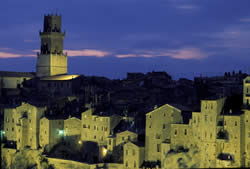- Home
- Destinations
4-8 8 12 26 10 10 10 10 10-12 10 10-11 8 8 9 7 2 8 
Etruria is a sparsely settled region with diversified landscape in southern Tuscany and to the north of Latium. The 8th century BC was the climax of the Etruscan culture. There are numerous 'treasures' (graves, hermitage and ruins) on hidden paths to discover, and the towns of Pitigliano and Sovana amongst others are well worth visiting.
Pitigliano

Pitigliano
The tiny town of Pitigliano perches atop a cliff in the southeastern part of Tuscany. Most of the town is carved from the porous tufa rock of the area, a volcanic by-product that is easily shaped into grottoes. Some of these caves date from the time of the Etruscans, between the 10th and 8th centuries BC and were used as wine cellars or sheds.
Pitigliano's fame, however, lies not in its Etruscan artefacts or architecture, but in its historically high percentage of Jewish residents. In the 13th century, many Jews moved from Rome to this town on Tuscany's border, seeking a place to make their living undisturbed. The synagogue and "unleavened bread bakery" attest to this. The town is first mentioned in historical annals of 1081 as being under the jurisdiction of the Orsini family. Pitigliano remained an Orsini property until the mid-16th century, when it entered the protection of the Medicis. By the 17th century, there was a ghetto large enough to earn Pitigliano the name "little Jerusalem."
Things to see
- The view of Pitigliano is breathtaking approaching from the access main road
- Fortezza Orsini with medieval plan, restructured in the 16th century
- Impressive tufa cellars
- Parco Orsini near the river Lente where there are eroded tufa rocks
- Duomo and Jewish synagogue

Isola Rossa Ltd 257 Dover House Road London SW15 5BZ info@isolarossa.co.uk
Copyright Isola Rossa Ltd
